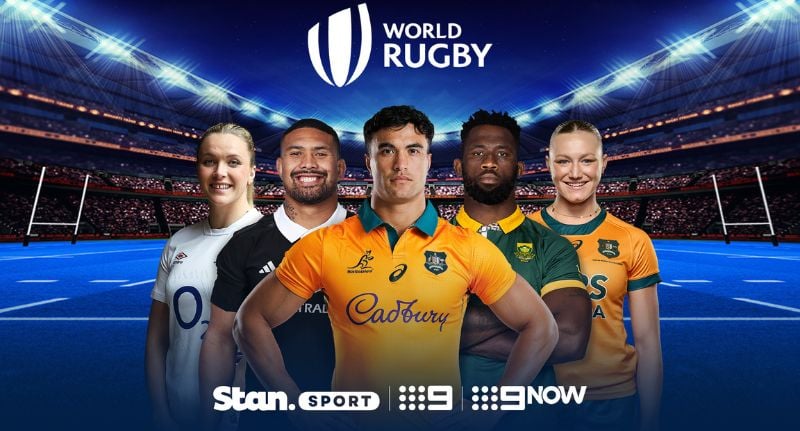In a landmark move set to redefine the dynamics of sports broadcasting in Australia, Nine Entertainment has revealed it has secured a five-year, multi-million dollar broadcast rights deal with World Rugby.
The rights coup not only reshapes the future of rugby broadcasting but also spotlights the country’s increasingly complex and fragmented sports media ecosystem.
From exclusive Rugby World Cup rights to Wallabies and Wallaroos test matches to Super Rugby saturation, Nine is doubling its cross-platform prowess. But what does this mean for rival broadcasters, advertisers, and sports fans navigating a jungle of subscriptions, free-to-air mandates, and digital-first experiences?
Let’s break it down.
Rugby’s ‘Golden Decade’ begins on Nine
Nine’s recent deals aren’t just big; they’re era-defining. From 2025 through 2029, Nine will become the home of virtually every major rugby event, including the men’s and women’s games.
That includes:
• The 2025 British & Irish Lions Tour
• Wallabies and Wallaroos Test Matches
• Super Rugby Competition
• The Women’s Rugby World Cup 2025 (UK)
• The Men’s Rugby World Cup 2027 (Australia)
• The Women’s Rugby World Cup 2029 (Australia)
Plus the World Rugby U20s, Pacific Nations Cup, WXV Tournaments, and the HSBC World Rugby Sevens Series.
Nine will use its full media arsenal, the 9Network, 9Now, and Stan Sport, to deliver comprehensive coverage across linear TV, on-demand streaming, digital publishing, audio, and more.
“This landmark partnership is all about reigniting the love of rugby down under,” said World Rugby Chair Brett Robinson. “With Nine’s unmatched reach, expert analysis, and comprehensive coverage… we’re offering a unique and immersive destination for fans in the country.”
All 52 matches of the 2027 Men’s Rugby World Cup will be streamed live on Stan Sport, with mini-matches, replays, and highlights.
The 9Network and 9Now will carry every Wallabies and Wallaroos match live and free (including as part of the Rugby World Cup), bringing the game back to the masses, but also nudging audiences deeper into Stan’s paid ecosystem.
According to Nine’s CEO Matt Stanton, the deal cements Nine as the home of rugby and “strengthens our position as the place for iconic national and international sport… across any and every platform.”
In an interview with Mediaweek earlier this year, Stan Sport director Ben Kimber praised the streaming platform’s partnership with Nine for its success: “It’s an absolute partnership with Nine. We’re a part of the same business. It’s actually an absolute strength.”
According to Kimber, this partnership not only expands Stan Sport’s reach but also reinforces a unified approach to content distribution and ad sales, providing a robust framework for both current and future advertising opportunities.

Stan Sport director Ben Kimber
Fragmentation nation: Where fans go, money follows
Sport in Australia used to be simple. NRL lived on Nine. AFL on Seven. Cricket bounced between Nine and, more recently, Seven. Foxtel owned the subscription sports broadcast market.
Then came Stan Sport, Kayo, Optus Sport, Paramount+, and Amazon’s quiet foray into tennis and surfing. Suddenly, watching sport in 2025 means juggling passwords and apps, or missing out.
Lachlan Gepp, who works as a media and sports rights lawyer at Addisons, explains the trend to Mediaweek: “We are definitely a more fragmented, more complicated sports rights market in 2025 in Australia than ever before. And we’re moving towards the types of sports rights markets you see in the US and the UK.”
Gepp says this evolution mirrors the rise of audience-first digital strategies, where sport is no longer bound by traditional free-to-air coverage and broadcasters are constantly looking for more content from rights holders and diverse distribution methods.
“What we’re really talking about in Australia,” said Gepp, “is the rise and emphasis of streaming platforms attached to traditional free-to-air broadcasters such as 7plus, 9Now and Stan and how they’ve fundamentally redrawn the local sports rights market.” While the big legacy players, Seven, Nine, Ten, and Foxtel, still dominate the landscape, they have introduced their digital streaming arms. They are no longer the only ones sitting at the negotiating table.
The recent takeover of Foxtel by DAZN, a foreign company that has been a stable and trustworthy partner for Australian sports for 30 years, signalled a seismic shift in the traditional pay-TV model.
For Gepp, DAZN’s takeover of Foxtel has introduced a “huge unknown” into the media landscape.
“DAZN’s record internationally is mixed; you just have to look at the recent controversy around their handling of French football broadcast rights to see that. Say nothing of their questionable financial performance in recent years and massive outlay on global sports rights.
“DAZN appears to be much more of a ‘cutthroat’ dollars and cents broadcaster and will probably be less worried about their relationships with sports executives in Australia. The AFL, NRL, and Cricket Australia would all be watching this closely,” he said.
Gepp also hinted at the prospect of even more strategic restructuring at Foxtel, suggesting that “DAZN could centralise management and production overseas and lean out the Australian operation.”
“On one hand, they may want a strong local executive team with experience handling sports rights deals in this market and legacy relationships with major Australian sports.
“On the other hand, sports rights deals are fundamentally driven by the same commercial drivers across the globe and they might back themselves to do it from London instead for cost efficiencies. The bedrock of pay TV sport in Australia is shifting under our feet wherever DAZN lands strategically,” he explained.
Add to that the digital extensions of existing broadcasters, and suddenly the sports rights conversation has morphed into a far more complex, multi-platform affair.
“Ten years ago, these digital streaming services barely existed in Australia; now they’re central to how rights are bought, sold, and consumed,” Gepp said. “That changes not just who’s bidding, but how those deals are structured and what they mean for fans, broadcasters, and advertisers alike.”

NRL’s Andrew Abdo and Patrick Delany
Foxtel’s Las Vegas NRL gamble
Speaking about Foxtel, the streaming giant has been playing its own high-stakes game, and doing it on foreign turf. The NRL’s American season opener in Las Vegas in March was a prime example of sports rights as theatre.
“We all know, especially with digital, you can get a very big reach, but are you getting true engagement?” Foxtel CEO Patrick Delany told Mediaweek at the time. “Vegas was like a grand final wrapped up with a magic round, a massive advertising event with extraordinary value.”
The event, simulcast across Fox League and Kayo, was pitched not just as a match but as a cultural moment and, more importantly, a subscriber magnet. As the battle shifts from broadcast to engagement metrics, it’s no longer about who airs the game but who owns the experience.
“There are so many more opportunities to continue to extend the brand, to integrate all of that sort of stuff, which our advertisers love,” Delany said. “Last year, this was our highest-rated event ever. So it’s one thing to integrate in and have brand extensions, but when you’ve got massive reach in one day, it’s a real smash-up for advertising.”
Advertisers, platforms, and the battle for attention
What Nine’s rugby deal clearly signals, much like Foxtel’s Vegas experiment, is a pivot towards high-impact events that capture attention across platforms and formats.
Catherine West, Chair of Nine, put it plainly: “Major sporting bodies know they can trust Nine to bring an exceptional experience for fans that builds interest not just in the event but also engagement in their sport. Rugby is living proof.”
For advertisers, that proposition is gold. Immersive, multi-platform coverage means brands can ride the highs of the Wallabies’ World Cup campaign across breakfast radio, prime-time TV, Instagram Reels, long-form newsletters, and a Stan Sport halftime show. It’s audience intimacy at scale.
As Gepp adds: “When you start to fragment rights, putting Super Rugby exclusively behind a paywall, but leaving Wallabies games on free-to-air, you create a funnel. The strategy is to build casual fans into core subscribers.”
So, who wins in the end?
For rugby, this is a moment of rebirth. With a decade of international tournaments on home soil and the most robust broadcast support in years, the sport may finally claw its way back into Australia’s mainstream.
For Nine, the deal is a strategic flex, combining its broadcast muscle with the agility of Stan and the reach of 9Now to create a vertically integrated sport content machine.
For fans? It’s a mixed bag. The quality, depth, and accessibility of coverage has never been better, but it comes at a cost, quite literally. Keeping up with all your favourite codes now means navigating a complex web of subscriptions, apps, and game times.
And for rival networks and streamers? The message is clear: this is a war for moments, not just minutes.
